I have a couple Audyssey MultEQ microphones from a couple HT receiver purchases (see pics below). I never gave them a thought. Figured they were junk. But recently, I have read on the net that they are quite quite flat and quite consistent. Unfortunately all I have seen concerns use of the mic for room eq. These mics are very solid and even come with a brass threaded insert on the bottom to use them on a tripod. Nice!
Any Audyssey enabled HT receiver comes with one of these mics. There are lots of them around. It sure would be nice to have information available on how to use these mics for speaker measurement and design.
So a couple questions come to mind:
The mics are designed to be used in the vertical position:
But for nearfield and other typical speaker measurements, mics are usually used in the horizontal position:
Unfortunately, a mic's freq. resp. may be very different in each position. Does anyone have info re freq. resp. and consistency for horizontal use? How about vertical use?
Even though they are reportedly quite flat, that can be improved with a cal file. Are there any generic calibration files available for horizontal use? How about vertical use?
Will these mics need a pre-amp?
And last, does anyone have experience, knowledge or suggestions re: using the Audyssey MultEQ microphones in speaker measurement and design? Care to share?
Thanks
Any Audyssey enabled HT receiver comes with one of these mics. There are lots of them around. It sure would be nice to have information available on how to use these mics for speaker measurement and design.
So a couple questions come to mind:
The mics are designed to be used in the vertical position:
An externally hosted image should be here but it was not working when we last tested it.
But for nearfield and other typical speaker measurements, mics are usually used in the horizontal position:
An externally hosted image should be here but it was not working when we last tested it.
Unfortunately, a mic's freq. resp. may be very different in each position. Does anyone have info re freq. resp. and consistency for horizontal use? How about vertical use?
Even though they are reportedly quite flat, that can be improved with a cal file. Are there any generic calibration files available for horizontal use? How about vertical use?
Will these mics need a pre-amp?
And last, does anyone have experience, knowledge or suggestions re: using the Audyssey MultEQ microphones in speaker measurement and design? Care to share?
Thanks
Microphones designed for use in the far field have a flat random incidence response curve ---> The vertical position--- it is better for far field measurements.
That means it is not flat at zero degree incidence (horizonal position).
Thx-RNMarsh
That means it is not flat at zero degree incidence (horizonal position).
Thx-RNMarsh
Thanks for the reply.
How are they different? If a mic is lets say a mic needs no calibration in the horizontal position. it measures perfectly flat. How would its response look if used horizontally?
And conversely, if a mic is inherently flat horizontally, what would its curve look like if used vertically?
I think this will help me understand what I am looking at.
Thanks for your comments.
How are they different? If a mic is lets say a mic needs no calibration in the horizontal position. it measures perfectly flat. How would its response look if used horizontally?
And conversely, if a mic is inherently flat horizontally, what would its curve look like if used vertically?
I think this will help me understand what I am looking at.
Thanks for your comments.
Some measurements...
Hi, I'm digging up this old thread, because I made some mic comparisons and think that it may be of interest to this community 🙂
I took two random samples of Audyssey AMC1HB microphones (serial numbers 070214 and 032114) and a DIY microphone using POM-2738P-R 6mm capsule (uncalibrated) for a comparison, using DIY mic preamp connected to Asus Xonar DSX soundcard line input. As per datasheet, DIY mic has around 5 dB rise from 3 to 10 kHz, then falls off.
Speaker used consists of two Fane Sovereign 8-225 in sealed box of approximately 60 liters volume crossed actively to ACR TT50 midrange and 22TAF/G tweeter; the latter two crossed passively at around 5 kHz. Measurements are taken from 30 to 50 cm distance between tweeter and midrange axis, except for polarity measurement which is taken at 20 cm distance from bass driver running full-range, approximately 30 degrees off axis.
Difference between samples, mics in horizontal position:
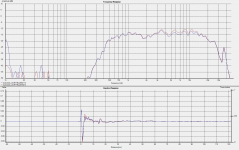
Difference between DIY mic and Audyssey mic, both in horizontal position:
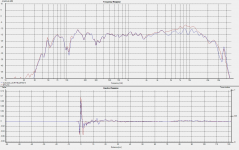
Difference in phase between Audyssey and DIY mic. Nearfield bass driver measurement. Note that bass drivers are connected with reversed polarity:
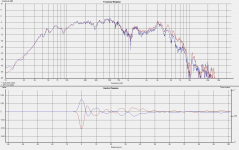
Difference of horizontal vs. vertical position:
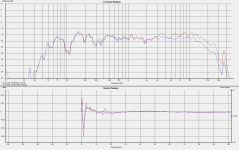
Difference between mic with foam block vs. without:
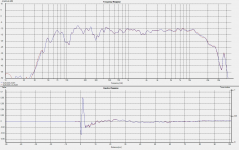
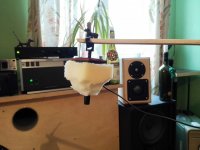
Differences between connection method: preamp; sound card front panel input; sound card rear panel input:
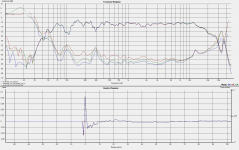
Conclusions:
1. Audyssey mics seem to be within their specification of +/-2 dB of variation between samples. Response curve seems to be quite flat, except for roll-off above 10 kHz
2. They are designed to be used vertically and using them horizontally introduces frequency range aberrations due to reflection from the mic base, this can be seen in impulse response (path length difference approx. 140 mm, microphone length from capsule to base is approximately 70 mm). Using a foam block around the mic smooths response further.
3. They seem to invert polarity compared to my DIY mic.
4. They work well enough connected directly to a sound card, but performance is limited by sound card mic preamp.
Hi, I'm digging up this old thread, because I made some mic comparisons and think that it may be of interest to this community 🙂
I took two random samples of Audyssey AMC1HB microphones (serial numbers 070214 and 032114) and a DIY microphone using POM-2738P-R 6mm capsule (uncalibrated) for a comparison, using DIY mic preamp connected to Asus Xonar DSX soundcard line input. As per datasheet, DIY mic has around 5 dB rise from 3 to 10 kHz, then falls off.
Speaker used consists of two Fane Sovereign 8-225 in sealed box of approximately 60 liters volume crossed actively to ACR TT50 midrange and 22TAF/G tweeter; the latter two crossed passively at around 5 kHz. Measurements are taken from 30 to 50 cm distance between tweeter and midrange axis, except for polarity measurement which is taken at 20 cm distance from bass driver running full-range, approximately 30 degrees off axis.
Difference between samples, mics in horizontal position:

Difference between DIY mic and Audyssey mic, both in horizontal position:

Difference in phase between Audyssey and DIY mic. Nearfield bass driver measurement. Note that bass drivers are connected with reversed polarity:

Difference of horizontal vs. vertical position:

Difference between mic with foam block vs. without:


Differences between connection method: preamp; sound card front panel input; sound card rear panel input:

Conclusions:
1. Audyssey mics seem to be within their specification of +/-2 dB of variation between samples. Response curve seems to be quite flat, except for roll-off above 10 kHz
2. They are designed to be used vertically and using them horizontally introduces frequency range aberrations due to reflection from the mic base, this can be seen in impulse response (path length difference approx. 140 mm, microphone length from capsule to base is approximately 70 mm). Using a foam block around the mic smooths response further.
3. They seem to invert polarity compared to my DIY mic.
4. They work well enough connected directly to a sound card, but performance is limited by sound card mic preamp.
It's not easy to compare measurement microphones. You might read:
"How Earthworks Measures Microphones"
How to measure microphones and the implications relating to measuring loudspeakers.
Earthworks Technical Articles
"How Earthworks Measures Microphones"
How to measure microphones and the implications relating to measuring loudspeakers.
Earthworks Technical Articles
- Status
- Not open for further replies.
- Home
- Design & Build
- Equipment & Tools
- Measurement Mic - Audyssey MultEQ microphone?